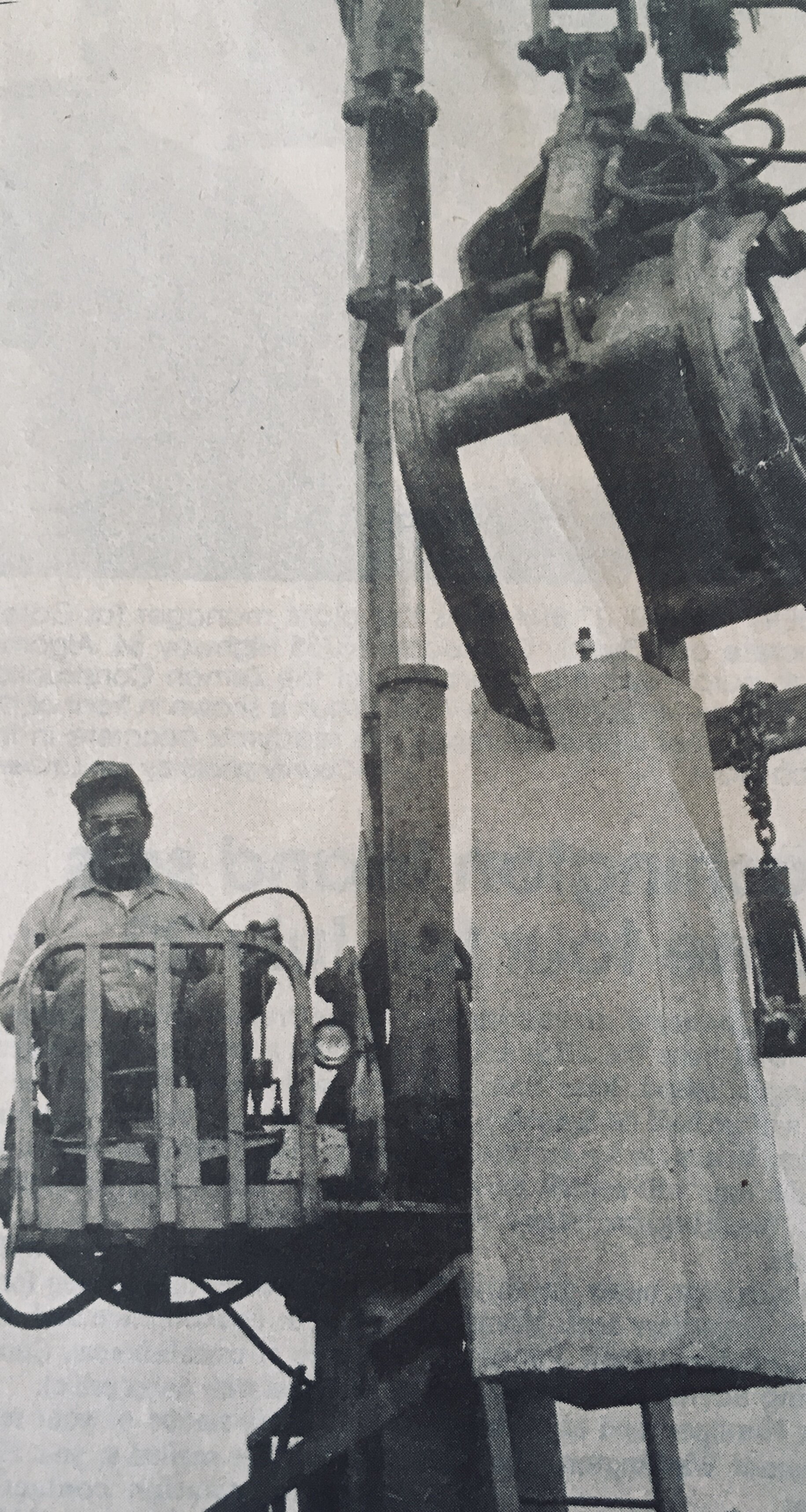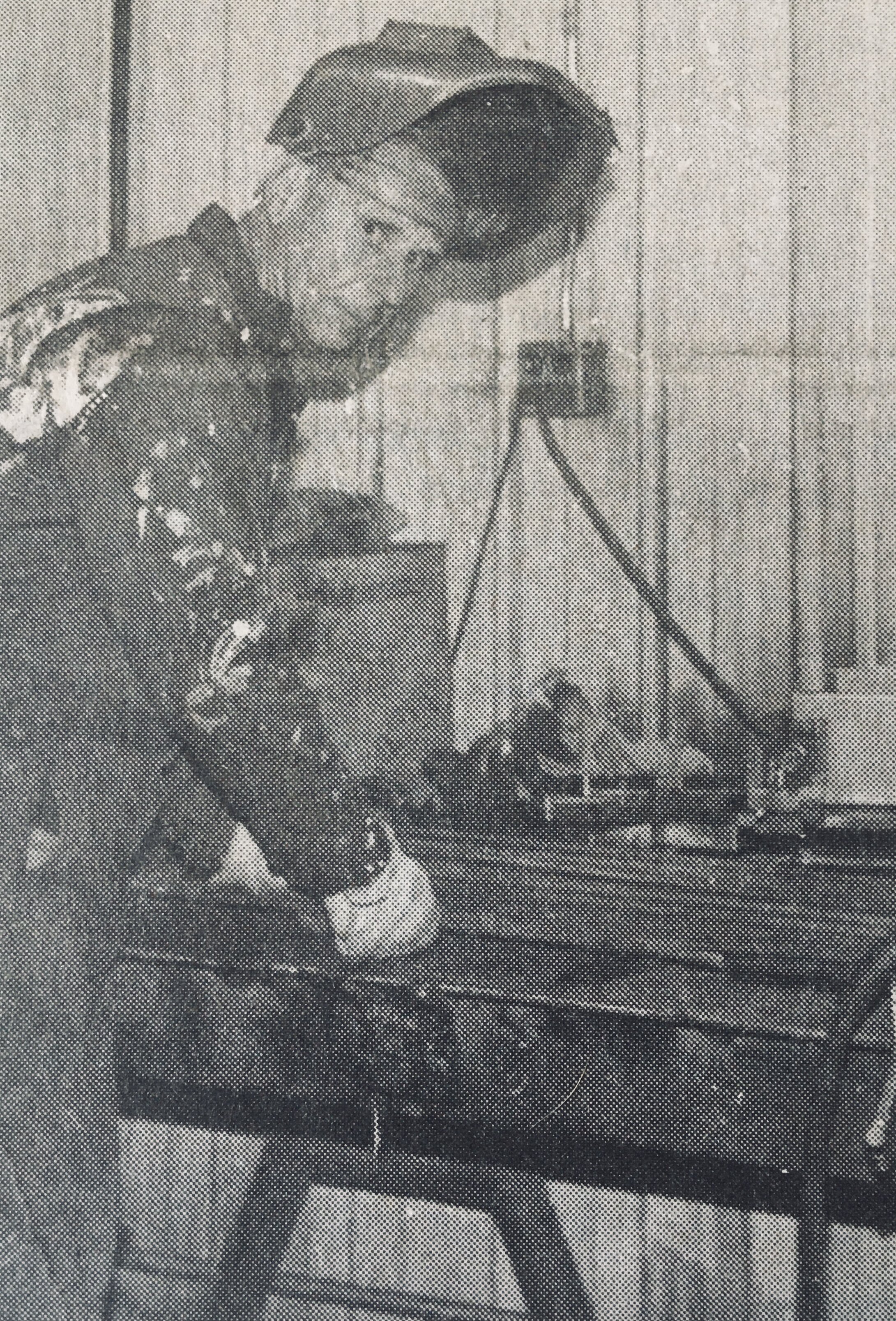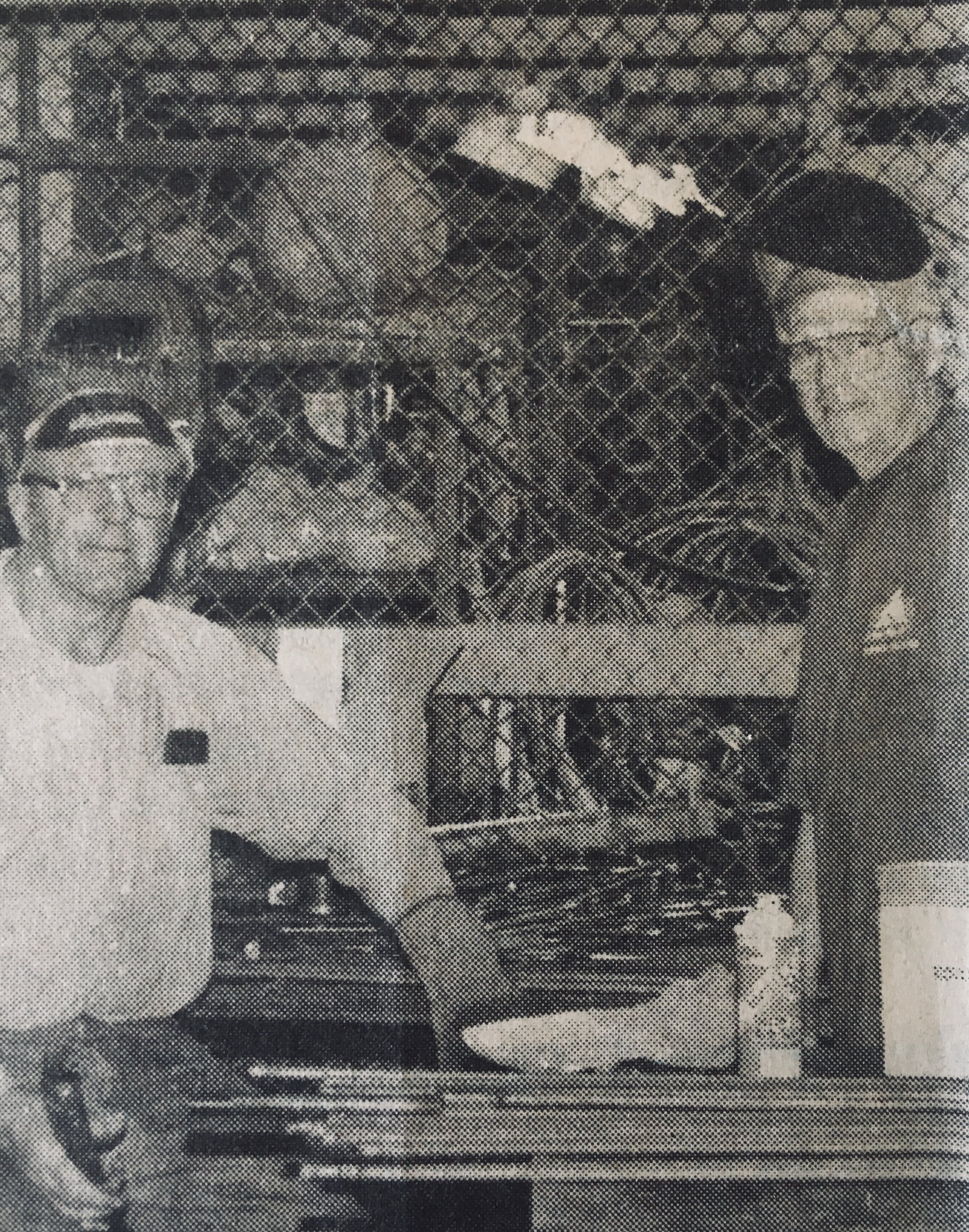Construction of the Boardwalk
Lasting over two years, the construction of the boardwalk was a community project from start to finish. Hundreds of hands helped out as the pillars were laid, decking frames built and landscaping installed. The following history has been compiled through research and interviews conducted by volunteers. To supply more us information, please fill out our online form or mail to Post Office Box 344, Algoma, Wisconsin 54201. Also, check out our list of volunteers to ensure your name or the name of a volunteer you know is included.
Led by Construction Manager Will Postma and engineer Jim Polzin, work on the boardwalk began in June 1995 with the processing of prepping, pouring and installing of the concrete pillars. All of this work happened at the city garage under direction of the Public Works Director Chuck Balleine. According to Bruce Heidmann, who later was co-awarded an Awards of Merit for Community Service for his work, “twenty plus wooden forms were built for the concrete pillars and each pour was reinforced with rebar. Each form was filled with approximately 1/3 yard of concrete. This was a very labor-intensive effort.” 460 massive concrete steel-rod enforced piers would be built, each weighing 900 pounds. 440 large anchor bolts were for the concrete piers were made at Monarch Ware. Heidmann mentioned the efforts of Bob Blahnik, an Algoma Lumber Company employee, who donated his time and skill with the Company’s log hauler equipment to load the concrete pillars and unload and place them on the beach. Joe Walag, Chuck Balleine and Tom Levy also assisted with pier settings.
Heidmann, Russ Stoller, and Postma leveled and buried every pillar. Each trapezoidal shaped pillar was buried four feet deep. The efforts started at the Visitor Center and moved north along the beach. Heidmann recalls that after they worked the first full day and got only eight pillars placed, they looked down the long beach and realized the huge job ahead. On July 13, 1995 the Algoma Record Herald quoted Postma “the walkway will be absolutely level, only one quarter of an inch variation in the entire length running from the Chamber building to the South Pier.
Construction Manager Will Postma and Engineer Jim Polzin work on anchor bolts at Monarch Ware.
Satran, Dan. (1995, June 01). Volunteers begin work, more are needed, as Algoma walkway project is underway. Algoma Record-Herald, pp. 1.
Post TV Ball Team Satran, Dan. (1995, July 27). Volunteers boost walkway project. Algoma Record-Herald.
Fred Waterstreet, Harold Zeitler, Dale Kirchman. St. John’s AAL Branch 1941. Courtesy Linda Teske.
Harold Zeitler, Fred Waterstreet, Dale Kirchman. St. John’s AAL Branch 1941. Courtesy Linda Teske.
John Zeitler and Harold Zietler, St. John’s AAL Branch 1941. Courtesy Linda Teske.
John Zeitler and Harold Zietler, St. John’s AAL Branch 1941. Courtesy Linda Teske.
Volunteers from the St. John’s AAL Branch 194. Back Row: Mark Teske, Fred Waterstreet, Harold Zeitler, Dale Kirchman, John Zeitler, Ken Breitlow. Middle Row: Jeanette Zeitler, Betty Kirchman, Brenda Zeitler, Mary Breitlow. Front Row: Aaron Breitlow, Katie Teske, Carmon Breitlow. Photo courtesy Linda Teske.
Bob Blahnik of Algoma Lumber Company moves piers.
Satran, Dan. (1995, July 6). Moving 450 concrete piers project for Bob Blahnik. Algoma Record-Herald.
Ensuring the boardwalk was level and accessible was a key feature of the project. It was important to ensure the compliance with the Americans with Disabilities Act, a sentiment echoed by Jeff Pagels of the Wisconsin DNR, a wheelchair user himself, who pushed early on for accessibility to be a key issue. One of the grants secured by the committee, based on the Federal Intermodal Surface Transportation Efficiency Act of 1991, recommended projects that enhanced mobility and quality of life. Algoma’s project was one of 230 projects submitted and 64 accepted. A later editorial in the Algoma Record Herald stated that “those of us, so pleased with this new Algoma feature, who watch the many who use it, must notice how frequently it is used by handicapped visitors in their wheelchairs.”
A new innovation in decking to aid with accessibility, recycled plastic deck panels were used. They were manufactured in Kewaunee County at NEW Plastics in Luxemburg. According to the original outreach letter from the company, over 275,000 milk containers would be recycled into the boardwalk project alone. The contract would also employ four people over two weeks, keeping the dollars local. The decking was built for the Wisconsin climate and used for marine applications with little to no maintenance required.
By July 1995, the pillar had been set and the work on the 5x10 foot sections of deck framing began. This work was done behind the Algoma Utility building and then hauled to the walkway. The concrete walkway descending from the Chamber was poured by Dennis Mertens. Three lamp posts were erected with more scheduled to be installed dependent on fundraising. Throughout the fundraising drive, all lampposts were funded for $16,750.00 and installed by competition of the project.
The decking was installed on site beginning in late July 1995. By mid-August it was near halfway completed and the parts that were finished saw heavy use, especially during Shanty Days weekend.
Completing the concrete ramp.
Satran, Dan. (1995, June 22). Algoma’s big project: build ramp, pouring 460 piers to support 2,600 foot walkway. Algoma Record-Herald, pp. 1.
The project drew a lot of volunteer participation. Work was done at the Utility building and people would drop in as time permitted. A lot of work was completed from 5-8:oo p.m. when people stopped after work to pitch in. Once volunteers got their marching orders, the work was routine and many people worked independently. A large representation of local people with construction experience helped out, including many of the same people who helped with the Visitor Center project. To see a list of names and organizations that volunteered for the boardwalk please click here. You can also submit a name for the list here.
By October 1995, all lampposts were installed and the electricity turned on. The official name – Crescent Beach Boardwalk – was reported at the November 6, 1995 City Council meeting. December 1995 saw the installation of some the benches. They were made of the plastic lumber manufactured by NEW Plastics.
Piers being poured.
Satran, Dan. (1995, June 22). Algoma’s big project: build ramp, pouring 460 piers to support 2,600 foot walkway. Algoma Record-Herald, pp. 1.
Signs, designed and manufactured by Jag Signs, were installed in May 1996. Although near completion, the Community Committee continued to call for volunteers for landscaping and sodding the remaining bank areas. A few more benches had to be installed. A removable ramp providing handicap access all the way to the water was slated for installation.
By August 1996, a majority of the landscaping was completed. It took over 5,000 cubic yards of fill, which amounted to over 250 truckloads, delivered over the year. While no taxpayer funds were used on the project, excess fill from city construction projects was delivered to the boardwalk site in lieu of disposal at a regular dump site. Stoller Construction aided in final contouring and donated many hours to the project. Grass was seeded on the south end of the park and the Master Gardner Club of Door County aided in planting native grasses and wildflowers on the north end. A Cherrington beach cleaner was purchased by the City to remove larger stones, vegetation, sticks and cigarette butts from the sandy beach below the boardwalk.
In May 1997 a group of Algoma citizens, Algoma government officials and Boardwalk point people met with the DNR to find a compromise on how late the park was lit. The city wanted the lights to stay on late to prevent vandalism and encourage safe use. The DNR felt it would inhibit crucial vegetative growth. As a result of the meeting, which was attended by over 50 people at the Algoma Chamber building, Algoma could amend its park ordinance to allow lights to stay on 24 hours if they amended their use of the beach cleaner. For one year the city was not allowed to use the cleaner within 16 feet of the boardwalk to see if natural dune grasses would grow. If no growth occurred, they could continue to use right up to the boardwalk. (Lawrenz, Lee. (1997, June 5). Boardwalk compromise pleases Algoma officials. Algoma Record Herald. Algoma Chamber of Commerce, 2021, February 16.)
Last of the 450, 900-pound steel rod reinforced concrete piers are placed.. Left to right: Will Postma, Russ Stoller, Bruce Heidmann, and Jim Polzin, all key persons in project.
Satran, Dan. (1995, August 31). Walkway half complete, fundraising continues. Algoma Record-Herald, pp. unknown.
The volunteers were honored at the Algoma Area Chamber Business and Community Awards Banquet in 1997. Bruce Heidmann and Will Postma were given the Award of Merit for Community Service, presented by Jim Polzin, for spending “countless hours to ensure the completion of the boardwalk project – spending 40-60 hours a week in often back breaking physical labor”. It is our desire, as the Friends of Crescent Beach, to honor those who donated their time and resources to the Crescent Beach Boardwalk with these accounts of history.
Friends of Crescent Beach is an all-volunteer organization working to research and compile information about the history of the boardwalk through interviews, newspaper clippings and records. If you have information you would like to add, please let us know by submitting through this link. We are collecting historical information, photographs, and personal stories of the boardwalk. If you would like to donate to preserving the boardwalk for another 25 years, please visit our donation page. All submissions become the property of Friends of Crescent Beach and are subject to editing for length, accuracy and clarity. Publication is at the sole discretion of Friends of Crescent Beach.












